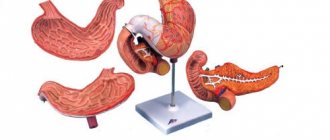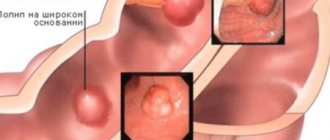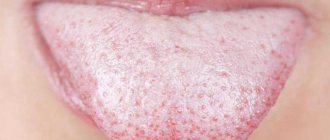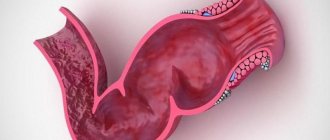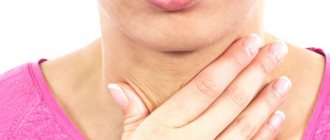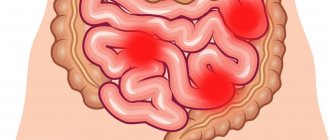Causes
The primary state of the disease is formed due to psychogenic factors affecting human health. The cause of the disease can be stress, tension, nervous breakdowns, depression, emotional turmoil. The diet also influences the development of the disease. Insufficient fiber intake leads to dyskinesia. The disease can manifest itself due to intestinal pathogens.
The secondary manifestation in most cases is a consequence of established chronic ailments or recently undergone surgical interventions of the abdominal organs - spleen, pancreas, liver. The disease is provoked by hormonal imbalances, the pituitary gland, and diabetes.
A secondary manifestation can be provoked by excessive use of medications - psychotropic drugs, anticonvulsants, antibiotics and muscle relaxants.
How to diagnose
Since various pathological processes can be a provoking factor for intestinal colic, to identify the true cause it is necessary to seek help from a specialist.
At the appointment, the doctor collects the necessary information and listens to complaints. After this, an external inspection is carried out .
With occasional bloating or poor nutrition, colic goes away on its own. If they occur against the background of a more serious disease, then a thorough diagnosis of the pathological condition is necessary.
A number of measures are prescribed, including laboratory and instrumental research.
These include:
- general and biochemical blood test;
- gastroduodenoscopy;
- colonoscopy;
- Analysis of urine;
- cholecystography;
- sigmoidoscopy;
- ultrasonography;
- computer and magnetic resonance tomography;
- analysis of stool.
If necessary, diagnostic examination can be supplemented with other methods.
Based on the results obtained, a final diagnosis is made and therapy is prescribed.
What diseases may the combination of these symptoms indicate?
- The cause of colic in adults can be diseases of the digestive system. Such diseases include ulcers, gastritis, malfunctions of the gallbladder, liver, and pancreas. In this case, digestive disorders occur. Food begins to be poorly digested. It enters the small intestine, causing painful spasms.
- Colic is caused by food intoxication from low-quality or expired food. Toxins accumulate in the body, causing bloating, vomiting and nausea. In this case, treatment must be started urgently, before the toxins have time to be absorbed into the human blood.
- Cramps and flatulence can cause intestinal infections. At the same time, pathogenic microbes enter the body and cause toxins. Intestinal infections include salmonellosis, cholera, and dysentery.
- The disease is caused by nervous diseases. These include stress and nervous tension. In most cases, this manifestation occurs in impressionable people who have a thin physique. Patients also suffer from congenital malposition of the intestines.
- An unpleasant manifestation is caused by infection with helminths. Parasites located in the intestines affect the mucous walls. At the same time, pain occurs in the abdomen and appetite decreases. A person loses weight catastrophically. Flatulence occurs and the person begins to swell.
- Another cause of an unpleasant illness is influenza and ARVI. Viral infections begin to affect the digestive and respiratory systems. Pathogenic microorganisms settle in the lymph nodes of the abdominal cavity. In this case, severe inflammation, colic and spastic pain occur.
- Intestinal colic occurs due to obstruction of stool in the intestines. There is a violation of his motility, the accumulation of feces in the intestines, the occurrence of pain, and stretching of the intestinal loops. The cause may be mechanical barriers in the form of adhesions or tumors. This manifestation is formed due to heavy lifting or intense physical stress on the body.
Clinical manifestations
Medical practice divides intestinal colic in adults, the symptoms accompanying them, into some types of pathology:
- Appendicular. Most of all, it serves as an initial sign in acute appendicitis. In this case, it is characterized by the appearance of a severe attack of pain that occurs unexpectedly; the patient feels a sharp pain that extends to the lower right side of the abdomen. This occurs as a result of inflammation that has begun in the appendage of the colon; the pain does not stop over time, but on the contrary becomes stronger.
- Rectal. Characterized by acute attacks of pain in the rectal area; they intensify over time; Along with them, the patient suffers from a painful urge to defecate.
- Lead. This phenomenon occurs when the patient’s body is exposed to lead poisoning, in most cases this is the result of hazardous production. It is characterized by acute, excruciating pain, which in turn strains the abdominal wall; periods of calm occur rarely; severe bleeding of the gums, they become covered with a white coating; The patient's temperature rises and may approach a critical level. In such a situation, immediate medical attention is required.
- Vascular. The main reason for this type of intestinal colic should be called a poor blood supply to the tissues of the intestinal muscles as a result of various pathologies - tumors, vein thrombosis, polyps and adhesions. Initially, the pain may be mild, slightly aching; but then they begin to intensify; due to oxygen starvation, attacks of sharp pain appear in the muscle tissues, which spread throughout the abdominal cavity.
Regardless of the initial reasons that contribute to the formation of painful spasms, the main symptoms in most cases are pain of a sudden, cramping nature, localized in the abdominal cavity and only intensifying over time. They manifest themselves, as a rule, after eating, but in diseases of a gastroenterological nature, their unexpected appearance is acceptable, and on an empty stomach, regardless of the time of day.
Muscle spasms may be accompanied by the following symptoms:
- if pain during attacks continues for a long time, then they begin to radiate to the lower back and tailbone area, creating the feeling that the pain has spread throughout the entire abdominal cavity;
- with prolonged spasm, an obstacle is created for the normal release of gases and feces, resulting in flatulence with severe bloating. The patient develops belching with nausea due to diseases such as gastritis or a stomach ulcer;
- in some cases, blood pressure suddenly increases, this does not apply to cases where the patient suffers from intestinal obstruction, in this situation, on the contrary, the pressure drops;
- the patient experiences a loss of strength, his health is steadily deteriorating, this condition is typical for acute intestinal obstruction;
- in the patient’s bowel movements (constipation, diarrhea) you can see not only mucus, but also an admixture of blood;
- The patient’s body temperature rises during spasmodic attacks, but only if provoked by poisoning or viral and intestinal infections.
In the event that the patient’s condition begins to steadily worsen from the moment the pain attacks begin, it is necessary to immediately seek medical help, since only a doctor can determine the reasons that caused such a condition. We must not forget that such serious conditions as intestinal obstruction, severe dysentery and poisoning require immediate treatment. Otherwise, the risk of death increases.
Symptoms
- Sharp pain in the abdominal area;
- Varied nature of the manifestation of pain, depending on the type of dyskinesia. Pain sensations can be girdling, dull, aching, cutting, or paroxysmal. May last for several minutes or hours;
- Painful sensations in the form of cutting stop at night, during sleep. But after awakening, the pain begins to torment the person again;
- Cramps form after eating. May occur after nervous breakdowns and emotional shocks;
- People experience problems with bowel movements. In most cases, diarrhea occurs;
- Frequent constipation begins to form. They are replaced by diarrhea with or without mucus. Relief occurs after the elimination of flatulence. At the same time, the intestines are emptied, gases are released, the stomach stops swelling, and bloating is eliminated;
- Adult patients experience constant rumbling in the stomach. Often such manifestations are the only symptom of a dangerous disease;
- People may experience dull pain in the back and heart area. Insomnia, irritability, and depression begin to develop;
If one or more symptoms appear, you should immediately consult a specialist.
The doctor must order a diagnosis, find the cause of the pain and prescribe appropriate treatment.
Intestinal colic in adults: symptoms
What could be the main signs of this phenomenon? The very first thing to note is sharp, severe pain in the intestines, usually coming in waves or spasms. They can be acute and growing. Most of all, the patient feels pain in the navel area, but often they are felt in the lower abdomen. There are fewer cases where patients complain of spasms in the lumbar region. Pain often begins in the groin area, with male patients radiating to the testicular area, and in female patients - to the area of the genital organ.
The duration of colic varies and in some cases it can last ten minutes or more, and sometimes it lasts only half a minute, or even less. However, when difficult situations occur, such symptoms may persist throughout the day. It should be noted here that patients experience other symptoms between attacks.
The nature of pain when intestinal colic occurs is also very diverse. The pain can be barely noticeable, or, on the contrary, pronounced. There are often complaints of paroxysmal, cramping, cutting and stabbing symptoms.
Intestinal colic should also be considered. Symptoms in adults typically include:
- Bloating, flatulence. It often becomes hard. The patient feels discomfort upon palpation.
- Stool disorders, patients experience both constipation and diarrhea. Often there is a disturbance in the formation of feces.
- Mucous discharge during bowel movements and white ribbons are found in the stool.
- State of nausea and dizziness.
Also, colic can appear after a lot of nervous strain or conflict. When the abdomen is felt during an attack, the patient feels severe pain, although the muscles, as a rule, are not relaxed. Body temperature remains normal.
When a patient has diseases such as acute gastritis, then the main symptoms of this disease may be accompanied by symptoms of a dyspeptic nature - vomiting and refusal to eat.
Types of intestinal dyskinesia
- Rectum. This type of disease is also called rectal colic. It is characterized by false acute painful sensations when emptying the rectum;
- Pancreatic. Formed when pathologies of the pancreas occur. Symptoms include diarrhea, gag reflexes, bloating, and nausea. Localization of pain occurs in the upper abdomen on the left. The nature of the pain is shingles. Due to this manifestation, pancreatic tumors and an acute form of pancreatitis may occur;
- Lead. This type of disease occurs due to lead intoxication. Adults experience cramping pain in the abdomen. There is an increase in body temperature to 39°C. Tension occurs in the muscles of the abdominal wall. The gums begin to bleed. Gray plaque appears between the gums and teeth. In most cases, such manifestations are observed in employees working in hazardous industries. People engaged in lead mining and smelting are exposed to this risk. The disease can occur in molar workers, workers producing cables and batteries;
- Hepatic. With this type of disease, pain and cramping are observed in the right hypochondrium. They can radiate to the shoulder and scapula on the right. In this case, patients experience a bitter taste in the mouth. A feeling of nausea begins to form. Vomiting with bile is observed. This disease is provoked by an acute form of cholecystitis, cholelithiasis;
- Appendicular. It is observed in the initial stage of acute appendicitis. Has intense increasing pain that occurs in the iliac region on the right;
- Renal. Accompanied by sharp, intense pains radiating to the genitals, groin and lower back. They may get worse with movement. Patients experience an increase in body temperature up to 39°C. There is a sharp decrease in blood pressure and urination problems. Vomiting and a feeling of nausea are formed. If specialists do not intervene in a timely manner, a person may faint and lose consciousness. This form of the disease occurs with tumors, urolithiasis, pyelonephritis, kidney tuberculosis;
Intestinal spasms, symptoms
This is the main symptom characterizing spasmodic contraction of the intestinal muscles. The pain has a wave-like rhythm. Severe spasms are replaced by periods of rest or do not seem very intense. Intestinal colic exhibits similar symptoms and they are often confused.
Flatulence
Increased formation and subsequent accumulation of gases together with spasms in the intestines indicate inflammatory bowel syndrome. This disease is characterized by discomfort, accumulation of gases in the abdominal area and dysfunction of the rectum, with no organic causes. Doctors believe that this syndrome appears under severe stress, emotional tension or due to poor quality food.
Loose stools
Diarrhea and cramps in adults can be caused by dysbacteriosis. Disturbance of the intestinal microflora occurs due to infection entering the body. Taking medications containing beneficial bacteria will help restore normal functioning of the organ.
If, during bowel movements, mucus, blood and a corresponding odor are found in the stool, we can talk about serious disturbances in the functioning of the digestive system.
Urge to defecate
Attacks of compression of the muscular apparatus of the rectum can create a feeling of the urge to defecate. However, the process does not lead to the expected result. The spasm itself is the cause of cutting, pulling, burning attacks, without the release of feces. The nature of the pain in this case is constant. The smooth muscles of the colon contract, causing a feeling of twisting in the abdomen and a false urge to go to the toilet.
Menstrual pain
Periodic pain in women is often accompanied by spasmodic pain in the intestines and even upset.
During menstruation, aching pain is felt in the lower abdomen. The causes of spasms are divided into natural and pathological. Natural pain during menstruation is associated with changes in the hormonal levels of the female body. An increase in the levels of hormones in the body - dopamine and norepinephrine - increases pain.
Children often experience unpleasant and painful sensations in the intestines. The small intestine becomes the source of spasm, and then muscle contraction occurs throughout the entire tract.
Intestinal contractions in a healthy child's body are similar to the ebb and flow of the tides - peristaltic waves. In the process of moving food, the muscles of the entire tract are involved. Painful sensations in a child appear due to excessive irritation of the walls of the digestive organs. Factors for this phenomenon:
- A large amount of food has arrived for digestion and the gastrointestinal tract cannot cope.
- Food on the go. Food enters the stomach poorly chewed, and a lump of food will go further through the system, without the ability to digest it.
- Poisons and parasites can interfere with the body's normal functioning and interfere with natural cleansing.
- Stress and overexertion, especially in school-age children, can cause cramps in the intestines and so on.
Frequent colic in the abdomen of young patients affects not only the stomach and intestines. A baby switched to an inappropriate formula often experiences an accumulation of gases in the abdomen and painful cramps.
Colic in an infant
An older child suffers from involuntary compression of internal organs due to pyloric stenosis (sharp contraction of the sphincter between the stomach and duodenum).
Intestinal spasms are not an independent disease; the list of symptoms and their severity depend on the underlying pathology.
- paroxysmal abdominal pain of mild, moderate or high intensity;
- feeling of fullness in the stomach;
- bowel disorders: diarrhea or delayed bowel movements and flatulence;
- pathological impurities in feces: mucus, blood, lumps of undigested food;
- nausea and vomiting;
- fever;
- deterioration in general health: weakness, chills, muscle aches, rapid pulse, decreased or increased blood pressure.
We recommend reading:
How does defecation occur in humans?
Depending on the duration, intestinal spasms can be acute (up to 3 days), subacute (up to six months) and chronic (more than six months).
The following symptoms are characteristic of irritable bowel syndrome:
- The appearance of pain around the navel;
- Feeling of heaviness in the lower abdomen;
- Constipation;
- Diarrhea;
- Flatulence;
- Belching of air, nausea and vomiting.
In severe cases, headaches occur, chills and cold sweats appear. If intestinal spasm is provoked by acute intestinal obstruction or thrombosis of mesenteric vessels, symptoms increase instantly. The pain spreads throughout the abdomen, the anterior abdominal wall becomes tense. With this development of the disease, the “quiet period” is especially dangerous, during which the pain disappears. Loss of sensitivity of the intestinal mucosa indicates the death of receptors due to the onset of necrosis.
Differences between intestinal colic and other similar conditions
- Intestinal colic is accompanied by severe abdominal pain that occurs due to problems with the gastrointestinal tract.
- Intestinal colic with bloating indicates the formation of flatulence.
- Spasms, colic, and a feeling of nausea may indicate food intoxication.
- Intestinal colic and bitterness in the mouth indicate liver failure.
- Acute pain on the right side, colic in the abdominal area may indicate an acute form of appendicitis.
If symptoms occur accompanied by colic in the stomach, you must contact a specialist to determine the cause. After diagnosis, appropriate treatment must be prescribed.
Non-pathogenic causes of intestinal colic
If colic happened for the first time, perhaps it arose against the background of psychogenic factors - stress, depression, nervous excitement. Most often, for this reason, impressionable asthenics suffer from intestinal spasms.
Attacks of abdominal colic are extremely painful
The most common cause of colic is considered to be poor diet. It leads to intestinal dyskinesia, that is, a violation of the tone of the muscle membrane and motility of this organ.
What exactly in the diet can cause cramps:
- fiber deficiency;
- the predominance of cold or stale food;
- frequent consumption of dishes created on the basis of fermentation (bread, kvass, beer, pickled and pickled vegetables);
- starvation diets and overeating;
- abuse of fast food, fatty and fried foods.
Abuse of fast food often leads to dyskinesia
Poisoning with low-quality food also causes painful spasms . Intoxication is caused not only by poisonous mushrooms or expired food. You can also be poisoned by dishes that look fresh, but the technology for preparing them is broken.
Signs of food poisoning
Diagnostics
In order to find the causes of the disease, it is necessary to undergo a diagnosis of the body.
Laboratory tests include:
- Coprogram;
- Biochemical and clinical blood test;
- Analysis of urine;
- Analysis of feces for hidden blood, which is not visible to the naked eye;
The cause of flatulence and colic can be found using instrumental examination.
This type of diagnosis includes:
- Ultrasound examination of the abdominal organs, thanks to which it is possible to identify the disease that provokes intestinal colic;
- Sigmoidoscopy, which is performed using an endoscope. Thanks to this device, a visual examination of the rectum occurs;
- Colonoscopy, in which the entire intestine is examined, identifying pathological changes;
- Computed tomography of the intestine, which is performed if a malignant tumor is suspected;
Intestinal infections
In order to prevent intestinal colic, it is recommended to adjust the diet and diversify the diet. Products necessary for normal peristalsis contain an increased amount of fiber. In addition, eating foods rich in fiber reduces the load on the digestive organs. Also, digesting plant foods does not require large amounts of enzymes and bile acids.
To prevent the occurrence of intestinal spasms, you should eat food 4-5 times a day, in such quantities that you leave the table with a slight feeling of hunger. There is no need to give up meat dishes at all. A variety of foods stimulates normal peristalsis, eliminating convulsive contractions of the intestines.
When should you see a doctor?
- A specialist should be contacted if dyskinesia occurs in young children under three years of age;
- Mandatory consultation with a doctor is necessary for older adults;
- If there are blood clots in the stool;
- If bile is present in the vomit;
- Seeing a doctor is necessary if spasms and cramps bother adult patients for a long time;
- If the pain is unbearably painful, accompanied by sharp pain in the abdominal area;
- If there is bloating, the formation of flatulence against the background of allergic reactions;
- Pregnant and lactating girls must consult a specialist;
- If the patient has had any surgical interventions in the abdominal cavity, resulting in cramping and aching pain;
Symptoms and manifestations
The formation of colic in the intestines is accompanied by various manifestations of the clinical picture.
General signs of the pathological process include:
- periodic pain;
- attacks of nausea and vomiting;
- increased sweating;
- anxiety;
- bloating;
- rumbling in the stomach;
- gas formation
Severe colic stops after bowel movement or gas release.
Symptoms of the pathology may vary depending on the disease that caused the spasms.
With the development of appendicitis, the pathological condition is accompanied by repeated vomiting and fever. The location of the pain syndrome is the umbilical region. The pain then spreads to the iliac region, located on the right side, is constant and may intensify.
If the cause is food poisoning, the patient complains of trembling, severe nausea, the presence of mucous impurities in the vomit, diarrhea, dry skin, and deterioration in general health.
When intestinal colic is provoked by stress, the symptoms will be as follows:
- increased tearfulness;
- the appearance of colic after a mental disorder.
When spasms occur against the background of tumors, the clinical picture has such signs as weakness, rapid loss of body weight, refusal of meat, and lack of performance. Over time, symptoms become more pronounced .
With obstruction, spasms of the intestines cause lethargy of the body, increased gas formation, and the appearance of bad breath.
Distinctive features of females and males
In men, pain begins to appear in the area of the testicles and groin area. In women, the primary location of pain is the fallopian tubes and uterus.
Medicines
In order to eliminate excruciating pain, antispasmodics are used.
| Name | Description | Contraindications | Prices |
| Drotaverine | It is a myotropic antispasmodic. | Contraindicated for hypersensitive people. | From 11 |
| Becarbon | Used for intestinal colic, hyperacid gastritis. | Contraindicated in angle-closure glaucoma. | From 50 |
Injections are prescribed as first aid.
| Name | Description | Contraindications | Prices |
| Atropine | Sold in drops. Prescribed for spasms of smooth muscle organs of the gastrointestinal tract. | Contraindicated in people with atropine intolerance. | From 50 |
| Papaverine | Used for spasms of smooth muscles of the abdominal cavity. | Contraindicated in people with liver failure. | From 36 |
| Diphenhydramine | Used for serum sickness and anaphylactic reactions. | Contraindicated in prostatic hyperplasia. | From 50 |
Drug treatment for abdominal colic
For abdominal colic in adults, it is strictly forbidden to treat yourself, which makes it necessary to consult a specialist.
Depending on the disease, anti-inflammatory, analgesic, choleretic, antispasmodic agents, sorbents and antibiotics are used. In many cases, it is necessary to take medications that prevent the occurrence of dysbiosis.
Sedatives
- Zelenin drops. They consist of tinctures of valerian, belladonna, levomenthol and lily of the valley. Used for renal colic.
- Valoserdin. Consists of phenobarbital, ethyl ester of bromoisovaleric acid, oregano and mint oils. Effective for intestinal colic.
- Afobazol. It is a tranquilizer, suppresses the manifestation of fear and anxiety, as well as intestinal colic.
Antispasmodic drugs
To alleviate the condition, it is necessary to use drugs from the group of antispasmodics. They will ease spasms, alleviating discomfort.
- No-spa – 2 tablets;
- Papaverine – 1 tablet;
- Belladonna extract – 2 tablets;
- Melissa infusion – 1 glass.
Read the popular article on the site: Menopause in women: symptoms, age-related characteristics, treatment with effective methods.
Sorbents
Sorbents relieve bloating and have a positive effect if colic is caused by overeating or poor nutrition.
- Festal. Helps speed up food digestion through enzymes. The content of bile accelerates the removal of digested foods from the body.
- Mezim. Speeds up the process of digesting food. Used after operations. May cause constipation.
- Espumisan. Has a carminative effect. The main component is simethicone, which removes gas from the intestines, eliminates heartburn, and reduces the secretion of gastric juice.
- Smecta. Helps when colic and bloating are accompanied by diarrhea.
- Enterosgel. The hydrogel included in its composition absorbs harmful substances and gas bubbles in the intestines.
- Activated carbon. Acts as a carminative and also removes toxins from the body.
Preparations based on belladonna leaf extract
Belladonna (belladonna) leaves are used to make antispasmodic and analgesic drugs.
- Tincture with 40% alcohol. Use 6-9 drops.
- Becarbon - tablets containing belladonna extract and sodium bicarbonate. Helps with intestinal spasms and increased stomach acidity. Use 1 pc. 2-3 times a day.
- Bepasal - tablets containing belladonna extract, phenysalicylate and papaverine hydrochloride. Eliminates spasms and inhibits bacterial growth. Use 1 pc. 2-3 times a day.
- Bellalgin is a tablet containing analgin, sodium bicarbonate and belladonna extract. Fights spasms and reduces pain.
Read the popular site article: Clotrimazole ointment, suppositories - instructions for use for women
Folk remedies
At home, treatment can be carried out using traditional methods.
- If your stomach is swollen, increased gas formation occurs, then you can eliminate this manifestation with the help of pumpkin seeds. The seeds are ground in a blender. Two teaspoons are poured into two glasses of boiling water. Add granulated sugar or natural honey. Consume thirty minutes before meals. The course of treatment is 5-6 days.
- Tansy flowers are an excellent remedy. One tablespoon of dry matter is poured into a glass of boiling water. Leave for 30 minutes, strain. Consume one third of a glass three times a day. The course of treatment is 2-3 days.
- If your stomach is swollen and there is diarrhea, then an infusion of alder cones, cinquefoil root, thyme, mint and dry nettle leaves will help. The ingredients are mixed in equal proportions. Two tablespoons of the mixture are poured into two glasses of boiling water. Consume half a glass twice a day.
Treatment at home
Intestinal colic can be treated at home only if an accurate diagnosis has been established . Before being examined by a medical professional, you must not:
- Take medications that eliminate symptoms - painkillers and antispasmodics.
- Give the patient laxatives, antiemetics, and cleanse the intestines with enemas.
- Apply heat or cold to the abdomen.
Mandatory components of treatment should be diet and symptomatic treatment, which helps relieve spasm from the smooth muscles of the intestine.
Medical nutrition
The diet for intestinal colic consists of eating mechanically and chemically gentle food and involves a gradual increase in the load on the gastrointestinal tract.
Basic principles:
- In the first hours after the onset of symptoms, fasting is recommended . Within a few hours, the intestines are completely freed of altered contents.
- Supply a sufficient amount of fluid, while the patient is given water at room temperature to drink frequently, but in small portions.
- After a fasting pause, they begin to feed the patient with easily digestible food. The daily ration is divided into 5-6 parts, the dishes are given heat-treated, pureed or whipped in a blender.
- Any food should be heated to body temperature before consumption.
- Spices and seasonings, salt, vinegar, smoked meats, fried foods, semi-finished products, and fast food are excluded from the menu.
After feeling better, the diet is expanded by introducing new dishes into the diet. If after 2-3 days the condition does not worsen, add new products, stop grinding food, allow fresh vegetables and fruits, baked goods, yeast bread.
Preventive actions
As a prophylaxis, to prevent the causes of the disease and further treatment, it is necessary:
- Lead a healthy lifestyle. You should give up bad habits - smoking and drinking alcohol;
- Spend as much time as possible outdoors;
- Do not be nervous, avoid conflicts, emotional turmoil;
- Adjust your diet. Meals should be balanced and complete. Conducted at certain hours;
- When preparing food, sanitary standards must be observed;
- It is necessary to conduct an examination of the body at least once a year;
- You should move more, play sports, and exercise. You can sign up for yoga or massage courses;
Bloating and colic can occur for various reasons. They may be a consequence of diseases of the gastrointestinal tract. Simultaneously with the disease, flatulence, bloating, and fever may occur. People may experience a bloated stomach. Treatment includes the use of medications and physical therapy. In particularly severe cases, surgical intervention is used.
There is useful information on the topic in this TV show.
Intestinal infections
For the proper functioning of the digestive system, the presence of bacteria that make up the microflora is required.
Viruses entering the intestines destroy the balance and lead to dysfunction of the peritoneal organs. The sigmoid colon is most vulnerable to infections. Taking medications containing antibiotics only worsens the condition of the body. Dysbacteriosis, diarrhea, nausea and cramps accompany intestinal infections. Normally, intestinal contractions occur in peristaltic waves: ebb and flow. The muscles of different parts work alternately: from the duodenum to the sigmoid colon. The rectum does not participate in the act of peristalsis, and contraction of the sphincter is not a manifestation of intestinal colic. Intestinal spasm develops when there is extreme irritation of the walls of the intestinal tract, which is caused by the following harmful substances:
- Poisons;
- Parasites;
- Salts of heavy metals;
- Bacteria and viruses;
- Products of the breakdown of intestinal walls due to circulatory disorders.
During stress reactions, in extremely rare cases, intestinal spasms develop, the symptoms of which manifest themselves in the form of profuse loose stools. Basically, this reaction is typical for animals. Only people in creative professions who suffer from neurasthenia are susceptible to manifestations of “bear disease.”
Spasm is a response of the smooth muscles of the intestinal wall to any pathological effect. Contractions occur when the intestines are irritated by gases or poorly digested food. Spasms are caused by inflammation of the mucous membrane, dysregulation of motor skills, and deterioration of blood supply. Pain receptors are stimulated and transmit signals to the brain.
Possible reasons:
- Errors in nutrition: excess of roughage, baked goods, fatty, fried foods, overeating.
- Intestinal infections: salmonellosis, dysentery, rotavirus gastroenteritis.
- Poisoning: food poisoning, household and industrial intoxication.
- Acute and chronic inflammation of the intestine: enteritis, spastic colitis.
- Food intolerance: lactase deficiency, celiac disease.
- Diseases of the liver, gall bladder and pancreas: chronic cholecystitis, hepatitis, pancreatitis.
- Helminthic infestation: ascariasis, enterobiasis.
- Irritable bowel syndrome is chronic abdominal discomfort combined with stool disorder.
- Nervous stress is a failure of autonomic regulation of motor skills in response to a stressful situation.
- Intestinal obstruction is an acute or subacute obstruction of the digestive tract due to a foreign body, tumor, feces and gallstones.
- Intestinal ischemia: thrombosis of mesenteric vessels, ischemic colitis.
The rhythm of life of a modern person can affect the functioning of the intestines, leading to unpleasant symptoms. Spasm is one of the consequences of an incorrect rhythm of life.
The intestine is a muscular organ that consists of smooth muscle cells. Like any muscle, these cells must contract and relax so that the intestines can move and digest food. When a smooth muscle cell contracts and cannot relax for a long time, this means that it is in spasm.
Cramping pain in the intestines may be accompanied by additional symptoms such as diarrhea or constipation, as well as bloating. A spasm can provoke either a retention of contents in the body or its excessively rapid movement. With constipation, the contents remain in the body for a long time, causing fermentation processes and increased gas formation.
Thus, a spasm can manifest itself not only as pain, but also as other unpleasant intestinal symptoms: stool disturbances and bloating. All these symptoms indicate that the intestines are not functioning properly, that is, they are “irritated.”1
Agree, a good intestine is an intestine that does not make itself known and works correctly.
Sometimes it is colic in the intestines in adults that indicates developing pathologies in the gastrointestinal tract. Treatment and symptoms of this problem are interrelated. The diagnosis, and therefore further treatment, depends on the description of the nature of spastic pain. Having determined that colic is caused by intestinal spasm, it is necessary to deal with the irritant that is the causative factor in the occurrence of intestinal spasm.
Often, cramping pain in the abdominal area appears due to excessive amounts of food consumed. Even if the products were of 100% high quality, the stomach could not fully cope with the volume of food supplied and could not digest it at the proper level. Gastritis and pancreatitis are considered one of the most common diseases that prevent complete digestion.
As a stress reaction of the body, colic in the intestines can occur in adults. How to treat a spasm in case of nervous excitement is quite difficult to answer. Naturally, the body’s response to any shock with spastic contractions of the intestine is not entirely standard for humans. For example, unexpected diarrhea in a frightened bear is a completely natural phenomenon. Most often, the problem lies in the congenital abnormal distribution of nervous excitation.
For colic, probably caused by an intestinal infection, it is advised to eat fresh artichoke roots and grated carrot and apple puree.
These vegetables are effective antiseptics in the gastrointestinal tract.
You can prevent the occurrence of colic in the intestines by adhering to the basics of a healthy diet and eliminating bad habits. Alcohol and smoking pose a danger to the entire body. Poor quality of drinking water can also have negative consequences on the state of the digestive system. In addition, you should not overuse self-medication. Only a doctor, after conducting an examination, will be able to make a diagnosis and prescribe appropriate therapy.
Treatment of spasms
The use of medications for spasms can lead to a response from the digestive system. A doctor should prescribe medication.
Drug treatment
Frequent involuntary muscle contractions can lead to more serious illnesses than just pain. To avoid worsening the situation, you can use medications.
To relieve symptoms temporarily, antispasmodics are used, which reduce cell tone in the muscular system of the body. They relieve pain by blocking nerve impulses traveling to the muscles.
The pharmaceutical industry produces medications in the form of tablets, injections, and suppositories.
Tablets for spasms - papaverine. Indicated for pain syndromes in the abdominal region, heart, blood vessels. Can be taken by pregnant women. Does not affect the human central nervous system. Side effect: drowsiness, allergies, possible constipation.
The medicine spasmalgon is available in the form of injections. When administered intramuscularly, muscle relaxation occurs faster.
Folk recipes
Pain in men and women arises from gastrointestinal dysfunction, bad habits, and alcohol abuse. Women experience discomfort during menstruation in the lower abdomen.
Traditional medicine in this case can help without harming other internal organs. Spasmodic plants can relieve symptoms one by one and relieve pain.
Medicinal chamomile
An infusion of this natural remedy can be taken continuously. Brew one tablespoon of the herb, let it brew and take two tablespoons every 2 hours during the day. If pain often bothers you, then take a course for a week.
The patient's menu should include more plant foods. If the pain is associated with the intestines, then it is better to boil, stew or bake vegetables. Also include onions, honey and carrots in your diet. Motherwort, oregano, mint, valerian, and lemon balm can also be mentioned as relievers.
Emergency relief of spasms
The main thing you shouldn’t do if your condition suddenly worsens is to panic. After all, nervous tension will only worsen the situation. It is necessary to immediately consult a doctor, since only a professional can correctly identify the problem and prescribe effective treatment.
If the attack is prolonged, you need to take strong antispasmodic medications or drink a decoction of mint, chamomile, valerian or calamus root. Taking medications is allowed only after consulting a doctor!



